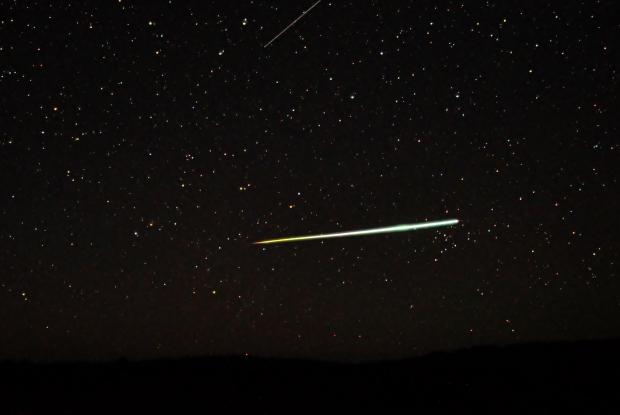
A shooting star or falling star 🌟 is actually not a star at all, but rather a small piece of space debris that enters the Earth's atmosphere and burns up, creating a streak of light in the sky. This debris is usually a meteoroid, which is a small rocky or metallic object that orbits the sun. When a meteoroid enters the Earth's atmosphere, it experiences friction and heat from the air, which causes it to vaporize and create the bright trail that we see as a shooting star.
A Shooting stars, or meteors, are caused by tiny specks of dust from space. These particles burn up 65 to 135 km above Earth's surface as they plunge at terrific speeds into the upper atmosphere, making the air glow as they pass.
If Earth moves at 29 km/s around the Sun, these bits of dust are travelling at about 40 km/s. When they enter our atmosphere they have a combined speed of 30 to 70 km/s (100,000 to 250,000 km/h), depending on whether or not they meet it head on! The meteors we know as the Perseids enter the Earth’s atmosphere at 60 km/s.
By comparison, the International Space Station moves at "only" 8 km/s in its orbit; capsules returning to Earth with astronauts on board enter the atmosphere at a similar speed.
A constant meteor shower
Our solar system is full of dust, which constantly comes into contact with Earth on its voyage around the Sun. This is the source of so-called “sporadic” meteors, a background phenomenon that produces about 10 shooting stars an hour.
However, there are parts of space where the dust is much denser. These clouds of miniscule debris are left behind by comets that break up as they repeatedly pass near the Sun. Earth passes through some of this dust around the same dates every year. The result is a meteor shower, a sudden spike in the number of shooting stars.
What is the radiant?
Meteor showers are generally named after the region of the sky (i.e. the constellation) where they seem to originate – in other words, the constellation where the radiant of the meteor shower is located. Because of a trick of perspective, the dust that Earth encounters as it moves around the Sun seems to come from the same vanishing point, in much the same way that snowflakes appear to be coming at you from a “tunnel” when you are driving through a snowstorm at night.
For instance, the famous Perseids, which we see each year around August 11-12, are so named because they seem to come from the constellation Perseus: they are caused by dust from the tail of comet Swift-Tuttle. In fact, there are dozens other such meteor showers that are for the most part much less intense and not as well known as the Perseids.
Other meteor showers
The Leonids (with a radiant in the constellation Leo) occur around November 18, and sometimes produce brief but very intense “storms” of shooting stars.
Around December 14, the Geminids (constellation Gemini) are as intense and reliable as the Perseids, but much less popular given the colder temperatures at this time of year.
Follow the techniques on the Observing shooting stars page, for a safe and enjoyable observation.
Source:
E-Space





